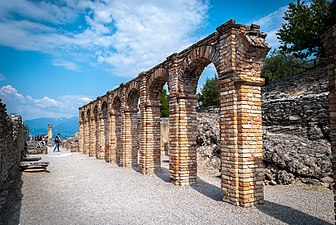
Gaius Valerius Catullus, often referred to simply as Catullus, was a Latin poet of the late Roman Republic who wrote chiefly in the neoteric style of poetry, focusing on personal life rather than classical heroes. His surviving works are still read widely and continue to influence poetry and other forms of art.

Tivoli is a town and comune in Lazio, central Italy, 30 kilometres north-east of Rome, at the falls of the Aniene river where it issues from the Sabine hills. The city offers a wide view over the Roman Campagna.

Lake Garda is the largest lake in Italy. It is a popular holiday location in northern Italy, about halfway between Brescia and Verona, and between Venice and Milan on the edge of the Dolomites. Glaciers formed this alpine region at the end of the last ice age. The lake and its shoreline are divided between the provinces of Brescia, Verona (south-east) and Trentino (north).

Capri is an island located in the Tyrrhenian Sea off the Sorrento Peninsula, on the south side of the Gulf of Naples in the Campania region of Italy. The main town of Capri that is located on the island shares the name. It has been a resort since the time of the Roman Republic.

Ascoli Piceno is a town and comune in the Marche region of Italy, capital of the province of the same name. Its population is around 46,000 but the urban area of the city has more than 93,000.
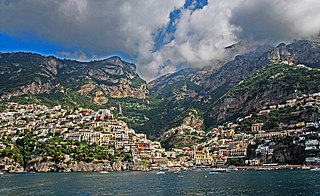
Positano is a village and comune on the Amalfi Coast, in Campania, Italy, mainly in an enclave in the hills leading down to the coast.

Desenzano del Garda is a town and comune in the province of Brescia, in Lombardy, Italy, on the southwestern shore of Lake Garda. It borders the communes of Castiglione delle Stiviere, Lonato, Padenghe sul Garda and Sirmione.

Sirmione is a comune in the province of Brescia, in Lombardy. It is bounded by Desenzano del Garda (Lombardy) and Peschiera del Garda in the province of Verona and the region of Veneto. It has a historical centre which is located on the Sirmio peninsula that divides the lower part of Lake Garda.

In Ancient Roman architecture a cryptoporticus is a covered corridor or passageway. The usual English is "cryptoportico". The cryptoportico is a semi-subterranean gallery whose vaulting supports portico structures aboveground and which is lit from openings at the tops of its arches.
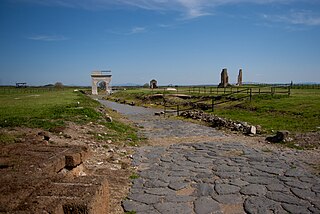
Vulci or Volci was a rich Etruscan city in what is now northern Lazio, central Italy.
Sirmio is a promontory at the southern end of Lake Garda, projecting 3.3 kilometers (2.1 mi) into the lake. It is celebrated in connection with the Roman poet Catullus, as the large ruins of a Roman villa known as the Grottoes of Catullus on the promontory have been supposed to be his country house. Catullus, upon his return home from a long voyage, joyously describes Sirmio as Paene insularum, Sirmio, insularumque ocelle in his Carmen XXXI, Ad Sirmionem insulam. A post station bearing the name Sirmio stood on the highroad between Brixia and Verona, near the southern shore of the lake. On the shore below is the village of Sirmione, with sulfur baths.

Bardolino is a comune (municipality) in the Province of Verona in the Italian region Veneto, located about 130 kilometres (81 mi) west of Venice and about 25 kilometres (16 mi) northwest of Verona.
Cottanello is a comune (municipality) in the Province of Rieti in the Italian region Latium, located about 60 kilometres (37 mi) north of Rome and about 15 kilometres (9 mi) west of Rieti.
Vacone is a comune (municipality) in the Province of Rieti in the Italian region Latium, located about 20 kilometres (12 mi) west of Rieti.
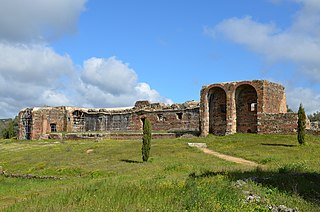
The Roman ruins of São Cucufate is a Romanesque archaeological site, located on the ruins of a Roman-era agricultural farm in the civil parish of Vila de Frades, in the municipality of Vidigueira, in the southern Alentejo, Portugal. The convent, which dates back to Middle Ages, was dedicated to the martyred saint Cucuphas.

Oplontis is an ancient Roman archaeological site located in the town of Torre Annunziata, south of Naples in the Campania region of southern Italy. The excavated site comprises two Roman villas, the best-known of which is Villa A, the so-called Villa Poppaea.

Stabiae was an ancient city situated near the modern town of Castellammare di Stabia and approximately 4.5 km southwest of Pompeii. Like Pompeii, and being only 16 km (9.9 mi) from Mount Vesuvius, this seaside resort was largely buried by tephra ash in 79 AD eruption of Mount Vesuvius, in this case at a smaller depth of up to five metres.
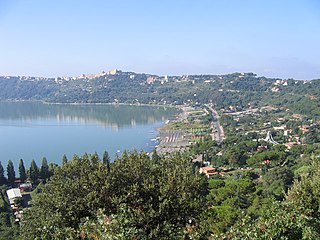
The Villa of Domitian, known as Albanum Domitiani or Albanum Caesari in Latin, was a vast and sumptuous Roman villa or palace built by Emperor Titus Flavius Domitian. It was situated 20 km outside Rome, in the Alban Hills, in the ancient territory of Ager Albanus.

The Rocca di Manerba del Garda is a rocky promontory, that extends along the south-western coast of Lake Garda, in Lombardy, Italy. The site, named after its medieval fortification period, is archaeologically significant, with human occupation evidenced from the Mesolithic, Neolithic, Bronze Age, Iron Age, ancient Roman and Medieval periods. Archaeological features include the ruins of this medieval fortification on the summit, and, on the south-western side of the peninsula, the remains of an ancient Roman villa. It consists of two main peaks: the Rocca Vecchia and the hill with the hermitage of San Giorgio.

The ancient Roman villa of Quintus Axius was a large rural villa rustica in the locality of Grotte di San Nicola, Colli sul Velino, Italy.










